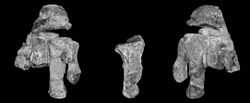Glacialisaurus
| Glacialisaurus Temporal range: Early Jurassic 189–183Ma | |
|---|---|
 | |
| Holotype foot | |
| Scientific classification | |
| Kingdom: | Animalia |
| Phylum: | Chordata |
| Clade: | Dinosauria |
| Suborder: | †Sauropodomorpha |
| Family: | †Massospondylidae |
| Genus: | †Glacialisaurus Smith & Pol, 2007 |
| Species | |
Glacialisaurus is a genus of massospondylid sauropodomorph dinosaur. It lived during the Early Jurassic period in what is now central Transantarctic Mountains of Antarctica. It is known from the holotype FMNH PR1823, a partial hind limb (foot) and from the referred material FMNH PR1822, a left femur. It was discovered and collected in the tuffaceous siltstones and mudstones of the lower part of the Hanson Formation, in Mount Kirkpatrick. It was first named by Nathan Smith and Diego Pol in 2007 and the type species is Glacialisaurus hammeri.[1] The generic name, Glacialisaurus, is derived from the Latin word glacialis, meaning "icy" or "frozen", in reference to the Beardmore Glacier region in the Central Transantarctic Mountains, where the fossil remains were found. The specific name, G. hammeri, honors Dr. William R. Hammer of Augustana College, who made major contributions to both paleontology and Antarctic research.[1][2]

In their phylogenetic analysis of the relationships of Glacialisaurus, Smith and Pol found that it is a massospondylid, a non-eusauropod sauropodomorph more advanced than other forms such as Saturnalia and Plateosaurus. Features of its foot are similar to Lufengosaurus (from the Early Jurassic of China), and the phylogenetic study suggests that Lufengosaurus may have been a close relative of Glacialisaurus, whereas other massospondylids such as Coloradisaurus and Massospondylus found to be more basal forms.[1] Recent cladistic analyses by Yates (2007), Yates et al. (2010, 2011) and Novas et al. (2011) found the same results.[3][4] The discovery of Glacialisaurus is important to the study of the early distribution of sauropod dinosaurs. The presence of this primitive sauropodomorph in the Hanson Formation (which has also yielded remains attributed to true sauropods) shows that both primitive and advanced members of this lineage existed side by side in the early Jurassic Period.[1][5]
References
- ↑ 1.0 1.1 1.2 1.3 Smith, Nathan D.; and Pol, Diego (2007). "Anatomy of a basal sauropodomorph dinosaur from the Early Jurassic Hanson Formation of Antarctica". Acta Palaeontologica Polonica 52 (4): 657–674.
- ↑ "A big find" (web). Scientists describe previously undiscovered dinosaur that lived 190 million years ago. The Antarctic Sun. December 20, 2007. Retrieved 2008-01-13.
- ↑ Yates, Adam M. (2007). "The first complete skull of the Triassic dinosaur Melanorosaurus Haughton (Sauropodomorpha: Anchisauria)". In Barrett, Paul M.; Batten, David J. Special Papers in Palaeontology 77. London: The Palaeontological Assoc. pp. 9–55. ISBN 978-1-4051-6933-2.
- ↑ Fernando E. Novas, Martin D. Ezcurra, Sankar Chatterjee and T. S. Kutty (2011). "New dinosaur species from the Upper Triassic Upper Maleri and Lower Dharmaram formations of central India". Earth and Environmental Science Transactions of the Royal Society of Edinburgh 101 (3–4): 333–349. doi:10.1017/S1755691011020093.
- ↑ Smith, N.D., Makovicky, P.J., Pol, D., Hammer, W.R., and Currie, P.J. (2007). "The Dinosaurs of the Early Jurassic Hanson Formation of the Central Transantarctic Mountains: Phylogenetic Review and Synthesis". U.S. Geological Survey and the National Academies 2007 (1047srp003): 5 pp. doi:10.3133/of2007-1047.srp003.